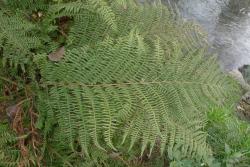Terrestrial ferns. Rhizomes erect (NZ) or rarely creeping (not NZ), scaly (NZ) and rarely hairy (not NZ). Rhizome scales non-clathrate, narrowly ovate. Stipes adaxially grooved, scaly. Laminae 2-pinnate to 2-pinnate-pinnatifid (NZ) or also entire and 3-pinnate-pinnatifid (not NZ), usually herbaceous, scaly (NZ) and sometimes hairy (not NZ), groove of rachis V-shaped and continuous with grooves of pinna midribs. Veins free. Sori elongated along veins and either single or bent across the vein at one end or horseshoe-shaped (NZ) or rarely round (not NZ), indusia same shape as the sori (NZ) or rarely absent (not NZ), opening away from the vein, entire or laciniate. Spores monolete, perispores nearly plain to rugose (NZ), rarely winged (not NZ).
A genus of c. 230 species (PPG 1 2016). Athyrium is one of the largest genera of ferns and one of the most taxonomically difficult, complicated by a high degree of hybridisation. It was circumscribed broadly by PPG 1 (2016), but Wei et al. (2018) segregated Anisocampium, Cornopteris, and Pseudathyrium as separate genera and recognised 10 sections within Athyrium.
Two naturalised species occur in New Zealand (Brownsey in Webb et al. 1988; Heenan et al. 2004).
| 1 | Secondary pinnae adnate to costa; basal acroscopic lobe on secondary pinnae about equal to other lobes | filix-femina |
| Secondary pinnae short-stalked; basal acroscopic lobe on secondary pinnae longer than other lobes | otophorum |
In New Zealand, species of Athyrium can be recognised by their 2-pinnate to 2-pinnate-pinnatifid scaly fronds, the presence of a V-shaped groove on the abaxial surface of the rachis, which is confluent with the grooves of the pinna costae, and their sori, which are J-shaped and bent across the vein at one end.
A widespread genus but one largely concentrated in the northern hemisphere, especially in eastern and south-eastern Asia and the Himalayas, with few species in the southern hemisphere (Kramer 1990). None indigenous to Australia or most of the Pacific islands. Two naturalised species in New Zealand.
| Category | Number |
|---|---|
| Exotic: Fully Naturalised | 1 |
| Exotic: Casual | 1 |
| Total | 2 |
The base chromosome number in Athyrium is x = 40 (Kramer 1990).




